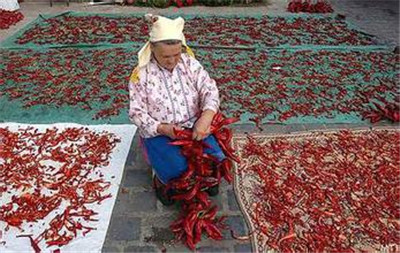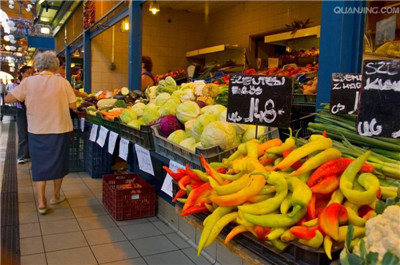For the Travel section’s Oct. 19 issue on Europe, writers and editors selected special items to profile from a dozen cities. Below, explore everything from chocolate in Brussels to silk in Florence to design in Copenhagen.
在欧洲版10月19日旅游板块,作者与编辑精选了十二个城市的独特珍宝,下面,我们从布鲁塞尔的巧克力、佛罗伦萨的丝绸到哥本哈根的设计,逐一欣赏吧。

Budapest: Paprika
布达佩斯的红辣椒
The job of preparing Hungarian paprika was once considered too dangerous for mothers to do. The peppers grown in Szeged — one of the country’s two primary paprika-producing regions — were so spicy that a woman who touched her children upon returning from work risked burning them, so only the elderly and unmarried were allowed the delicate task of separating the membrane from the flesh. But by the early 20th century, sweeter varieties and a machine that extracted the veins turned paprika into an equal opportunity employer and a common feature of all Hungarian cuisine. “Goulash, porkolt, the cold cheese spread called korozott that all Hungarians eat on bread at least once a month,” said the Budapest-based food journalist Dorottya Czuk. “All of our basic dishes have it.”
匈牙利人曾经认为,让妈妈来加工匈牙利红辣椒太危险了。这种辣椒生长在全国两大辣椒产地之一赛格德,它实在太辣了,如果一位母亲加工辣椒时不小心摸了孩子,孩子可能会被灼伤。所以,把一层薄膜从辣椒果肉上剥离,这种工作只能由年长者或未婚人士专职去做。但到了20世纪早期,出现了味道较淡的品种,人们又发明了抽出辣椒脉络的机器,于是加工辣椒就成了人人可做的工种,香辣也成了匈牙利菜肴的共同特点。“炖牛肉、炖猪肉,用柯罗佐冷芝士搭配面包,我们匈牙利人每月至少吃一次。”布达佩斯的美食记者多洛缇娅·查克(Dorottya Czuk)说。“这些基本菜肴中都有红辣椒。”
So omnipresent is paprika that you can get it at any Budapest supermarket, but the chains offer no guarantee of quality or origin. “It might be from Spain or, worse, China,” Ms. Czuk said. “I can tell you that nine Hungarians out of 10 would not want to eat paprika grown in Spain.” Look instead for tins, like those from Molnar or Hodi, that are produced locally.
红辣椒无处不在,你可以在布达佩斯任何一家超市买到,但却无法保证质量或正宗口味。“说不定你买到的辣椒是西班牙制造的,甚至更糟糕,中国制造。”查克女士说。“我敢说十个匈牙利人有九个都不想吃西班牙红辣椒。”所以你要寻找那些罐装的红辣椒,比如产自摩尔那或霍迪的,那些才正宗。

The Central, or Great, Market Hall is a good place to start. Built at the end of the 19th century its soaring brick, iron and tile exterior alone is worth visiting. But three stories of stalls inside hold their own delights, paprika chief among them. On Fridays and Saturdays, farmers sell their homemade spice in transparent plastic bags. “That’s good,” Ms. Czuk said, “because you can see how red it is. You want a really vibrant color.”
中央集市或曰大集市是一个好起点。房屋建于19世纪末,仅仅是那高耸的砖墙、铁栏和瓷砖贴面就值得游览一趟了。集市里有三层摊位,摆满了让本地人自豪的特产,主要就是红辣椒。每到周五和周六,农人们就把自家种植的香料装在透明塑料袋里来此地兜售。“很好。”查克女士说,“因为你可以隔着袋子看到它有多红。你会想要真正热烈的颜色。”
Aroma is also important: Fresh paprika should smell sweet and a little funky, like hay in a stable. And there are different categorizations: kulonleges, or “special quality,” is the mildest and sweetest; eros is the spiciest. But taste is the most important guarantor. Paprika is cheap enough (100 grams of even the highest quality spice cost around $2) that you can buy some, try it and feel that you haven’t wasted much money if you don’t like it.
气味也很重要:新鲜的红辣椒闻起来应该略淡,有一丝臭味,像马厩中的干草。而且有不同的分类法:库隆勒格斯意为特殊品质,指的是最温和、最淡的;艾洛斯则是最辣的。但口味是最重要的保证。红辣椒非常便宜(最优质的辣椒粉售价仅为100克2美元),可以买些尝尝,即使不合口味,也不费多少钱。
At Tasting Table it’s possible to forgo that step. The brand-new shop, at Brody Sandor utca 9, in the cellar of a 19th-century palace, features Hungarian wines and local specialty foods. It offers tastings of all its products, including Molnar and Hodi paprikas. “We spread goose fat from the foie gras we serve on bread, and sprinkle the paprika on that, said Gabor Banfalvi, a co-owner. “Because paprika needs fat to come to life.” LISA ABEND
在尝味台(Tasting Table),更是免不了这一步。这家全新的店铺位于布罗迪山铎9号一座19世纪宫殿的地下室里,专营匈牙利酒与本地特产美食。店内所有食品都可以品尝,包括摩尔那和霍迪红辣椒。“我们面包上涂抹的是从鹅肝酱中提取的鹅脂,再撒上辣椒粉。”店主之一嘉宝·山铎(Gabor Banfalvi)说。“因为红辣椒需要脂肪才能更好地展现辣味。”丽莎·阿本德(LISA ABEND)供稿。














